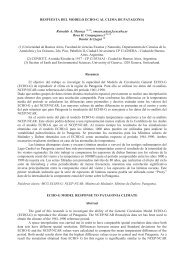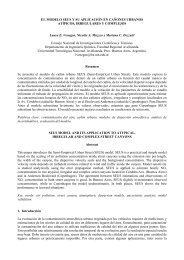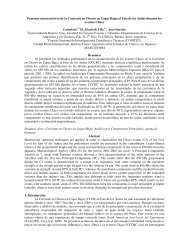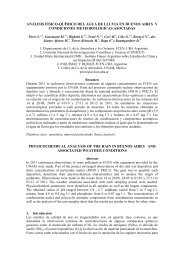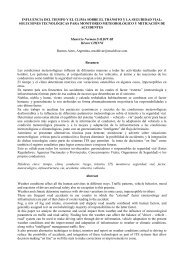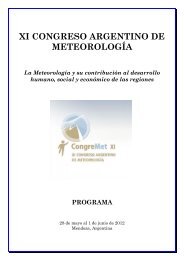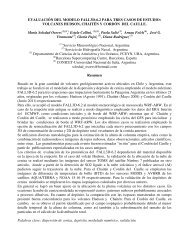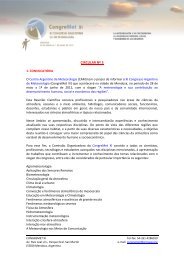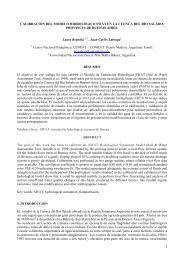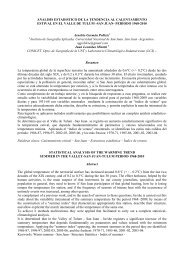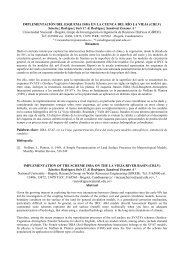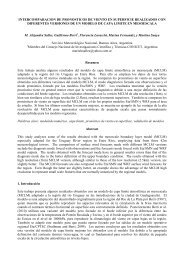LA METEOROLOGIA EN TIEMPOS DE LAS REDES SOCIALES ...
LA METEOROLOGIA EN TIEMPOS DE LAS REDES SOCIALES ...
LA METEOROLOGIA EN TIEMPOS DE LAS REDES SOCIALES ...
Create successful ePaper yourself
Turn your PDF publications into a flip-book with our unique Google optimized e-Paper software.
<strong>LA</strong> <strong>METEOROLOGIA</strong> <strong>EN</strong> <strong>TIEMPOS</strong> <strong>DE</strong> <strong>LA</strong>S RE<strong>DE</strong>S <strong>SOCIALES</strong>Mauricio Norman SALDIVARM. Saldivar & Asociados, Buenos Aires, Argentina, msaldivar@msaldivar.comResumenLas redes sociales se han convertido en una vía de comunicación revolucionaria en permanente evolución yque permiten conectar a un significativo número de personas en forma simultánea y con el plus de poderrecurrir a ellas cuando otras formas de comunicación son extemporáneas o no están disponibles.Compañías y profesionales de la meteorología en forma individual y muchos organismos responsables deltiempo y el clima a nivel local, regional o nacional, ya están incursionando con éxito variable de lautilización de estas herramientas que permiten interactuar con los usuarios compartiendo información yconocimientos.Las tecnologías asociadas a las redes sociales permiten una interoperatividad tal que en muchos casos es laúnica forma de comunicarse en casos de emergencia. En consecuencia, esta ventaja puede y debe seraprovechada por los organismos responsables de la vigilancia meteorológica, en reciprocidad con el usuario.Organismos meteorológicos estatales como NOAA y Met Office ya han comenzado a aprovechar el poder deconectividad de las redes sociales para mejorar la obtención de información a través de la colaboración delos usuarios mejorando su productividad (mejores pronósticos), la innovación en el servicio, la reputacióndel organismo y la forma en que se involucra éste con la sociedad.En este trabajo se analizarán las ventajas y desventajas de las principales plataformas, la manera en que sepuede gestionar el conocimiento adquirido a través de ellas, y también se desmitificarán los temores quepuede generar el disponer de un feedback del usuario “sin filtros” a través del manejo de la reputación.También se tratan los factores se deben tener en cuenta para definir la estrategia del Organismo alincursionar en las redes sociales, la metodología de trabajo, las metas, contenidos y los costos de utilizar lasocial media; y se analizan algunos casos exitosos en situaciones de crisis,Indudablemente se vislumbra un “antes y un después” en la manera de informar el tiempo en tiempos de laWEB 2.0.Palabras clave: redes, sociales, web 2.0, comunicación, estrategia, información, interacción, compartir,distribuir, alertas, Twitter, Facebook, You TubeAbstractSocial networks have become a new and revolutionary way for communication and also for connecting to asignificant number of people simultaneously and with the extra capability to use them when other forms ofcommunication are timeless or unavailable.Companies and professionals from the field of meteorology, and many agencies responsible for weather andclimate at local, regional or national level, are already making inroads with variable success using these toolsto interact with users sharing information and knowledge.The technologies associated with social networks allow interoperability such that in many cases is the onlyway to communicate in emergencies. Consequently, this advantage can and should be used by the agenciesin charge of monitoring weather, interacting with the user.National meteorological agencies like NOAA and Met Office have already begun to harness the power ofsocial network connectivity to improve the collection of information through the collaboration of users byimproving their productivity (better forecasts), giving innovation in service, improving the agency reputationand how it engages with society.In this paper I do analyze the advantages and disadvantages of all major platforms, how you can manage theknowledge gained through them, and also to put in real dimension the fears that can generate have a userfeedback "without filters" through the management of reputation.It also discusses the factors to be taken into account to define the Agency's strategy to move into socialnetworks, work methodology, goals, content and costs of using social media, and discusses some successstories in situations crisis.
Doubtless, there are a "before and after" in the way of reporting the weather in the age of WEB 2.0.



